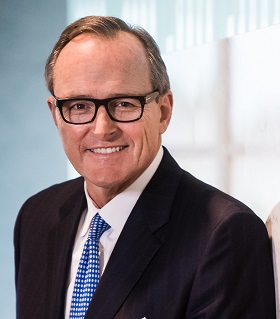The chief investment officer (CIO) is a job title for the board level head of investments within an organization. The CIO's purpose is to understand, manage, and monitor their organization's portfolio of assets, devise strategies for growth, act as the liaison with investors, and recognize and avoid serious risks, including those never before encountered. [1] [2] [3]
According to a press release on October 22, 2008, the United States Department of the Treasury named James H. Lambright to serve as the interim chief investment officer for the Troubled Asset Relief Program. "He will provide counsel to Secretary Henry M. Paulson, Jr. and Interim Assistant Secretary for the Office of Financial Stability Neel Kashkari as they develop and implement the program." [4]
Whenever the role of the chief investment officer is active within an insurance company (either life or non-life) and/or pension fund, the role is to manage and coordinate the investment, liquidity (treasury) and/or asset and liability management in order to optimize investment performance within the risk appetite as defined by actuarial studies of risk management guidelines.[ citation needed ] The role of a chief investment officer within a corporate pension organization is similar, although the end-goal for the chief investment officer is often not profit, but matching the organization's pension assets with its pension liabilities. [5] Chief investment officers at endowments and foundations also consider the liabilities of the organization, with an added focus on liquidity and alternative assets. [6]
Jonathan Hirtle, Chief Executive Officer for Hirtle, Callaghan & Co., [7] pioneered the outsourced chief investment officer (OCIO) model, which serves family groups and organizations that do not employ fully staffed investment departments. [8] [9] For his OCIO innovations, Hirtle has been dubbed the “"Oracle of Outsource". [10]
The model by which outsourced CIOs service clients is still evolving in this nascent business. The most common model is to outsource all decision-making including asset allocation, manager selection and monitoring. The OCIO reports back to the client, but the burden is largely lifted from the client and placed on the new provider. Among OCIOs utilizing this approach, there is a "continuum of outsourcing approaches and providers: manager-of-manager programs; funds-of-funds; former CIOs offering a diversified model portfolio". [11] The common thread amongst these approaches is the use of commingled funds or model portfolios which creates economies of scale for the OCIO.
A different model is pursued by a small subset of the OCIO universe. The members of this group work alongside the client's staff – not as a replacement to them. According to investment industry newsletter FundFire, "An increasing number of CIOs see outsourcing not as a threat to their job, but as a source of complementary expertise and advice, as well as investment opportunities." Like much of the nomenclature around the OCIO business, this more customized, bespoke solution does not yet have a widely recognized name. Fiduciary Research (FRC), an OCIO who oversees about $9 billion on behalf of a small list of pension fund clients, calls itself an iCIO for integrated chief investment office. [12]

The International Finance Corporation (IFC) is an international financial institution that offers investment, advisory, and asset-management services to encourage private-sector development in less developed countries. The IFC is a member of the World Bank Group and is headquartered in Washington, D.C. in the United States.
In business, economics or investment, market liquidity is a market's feature whereby an individual or firm can quickly purchase or sell an asset without causing a drastic change in the asset's price. Liquidity involves the trade-off between the price at which an asset can be sold, and how quickly it can be sold. In a liquid market, the trade-off is mild: one can sell quickly without having to accept a significantly lower price. In a relatively illiquid market, an asset must be discounted in order to sell quickly. Money, or cash, is the most liquid asset because it can be exchanged for goods and services instantly at face value.

Russell Investments is an investment firm headquartered in Seattle, Washington.

The California Public Employees' Retirement System (CalPERS) is an agency in the California executive branch that "manages pension and health benefits for more than 1.5 million California public employees, retirees, and their families". In fiscal year 2020–21, CalPERS paid over $27.4 billion in retirement benefits, and over $9.74 billion in health benefits.

PIMCO is an American investment management firm focusing on active fixed income management worldwide. PIMCO manages investments in many asset classes such as fixed income, equities, commodities, asset allocation, ETFs, hedge funds, and private equity. PIMCO is one of the largest investment managers, actively managing more than $2 trillion in assets for central banks, sovereign wealth funds, pension funds, corporations, foundations and endowments, and individual investors around the world. PIMCO’s headquarters are in Newport Beach, California; the firm has over 3,100 employees working in 22 offices throughout the Americas, Europe, and Asia.

Bridgewater Associates is an American investment management firm founded by Ray Dalio in 1975. The firm serves institutional clients including pension funds, endowments, foundations, foreign governments, and central banks.

Ranji H. Nagaswami was Chief Executive Officer of Hirtle, Callaghan & Co. She has nearly 30 years of distinguished investment and executive management experience in the industry in both the private and public sector. In recent years she served as Operating Partner and Senior Advisor at Corsair Capital, a leading global private equity firm focused on investing in the financial services industry and prior to that worked at Bridgewater Associates, the $130 billion global macro hedge fund and risk-parity strategy pioneer.
Asset and liability management is the practice of managing financial risks that arise due to mismatches between the assets and liabilities as part of an investment strategy in financial accounting.
Mercer is an American consulting firm founded in 1945. It is one of the four operating subsidiaries of global professional services firm Marsh McLennan. Mercer is headquartered in New York City with offices in 43 countries and operations in 130 countries. The company primarily provides human resources and financial services consulting services to its clients.

Alberta Investment Management Corporation (AIMCo) is an Albertan Crown corporation and institutional investor established to manage several public funds and pensions headquartered in Edmonton, Alberta. AIMCo was established by an act of the Legislative Assembly of Alberta in 2008 under the government of Progressive Conservative Premier Ed Stelmach.
The California State Teachers' Retirement System (CalSTRS) provides retirement, disability and survivor benefits for California's 965,000 prekindergarten through community college educators and their families. CalSTRS was established by law in 1913 and is part of the State of California's Government Operations Agency. As of September 2020, CalSTRS is the largest teachers' retirement fund in the United States. CalSTRS is also currently the eleventh largest public pension fund in the world. As of October 31, 2020, CalSTRS managed a portfolio worth $254.7 billion.

Angelo Gordon is a global alternative investment manager founded in November 1988 by John M. Angelo and Michael L. Gordon who together ran the arbitrage department of L.F. Rothschild in the 1980s.
On March 23, 2009, the United States Federal Deposit Insurance Corporation (FDIC), the Federal Reserve, and the United States Treasury Department announced the Public–Private Investment Program for Legacy Assets. The program is designed to provide liquidity for so-called "toxic assets" on the balance sheets of financial institutions. This program is one of the initiatives coming out of the implementation of the Troubled Asset Relief Program (TARP) as implemented by the U.S. Treasury under Secretary Timothy Geithner. The major stock market indexes in the United States rallied on the day of the announcement rising by over six percent with the shares of bank stocks leading the way. As of early June 2009, the program had not been implemented yet and was considered delayed. Yet, the Legacy Securities Program implemented by the Federal Reserve has begun by fall 2009 and the Legacy Loans Program is being tested by the FDIC. The proposed size of the program has been drastically reduced relative to its proposed size when it was rolled out.
Fiduciary management is an approach to asset management that involves an asset owner appointing a third party to manage the total assets of the asset owner on an integrated basis through a combination of advisory and delegated investment services, with a view to achieving the asset owner's overall investment objectives. In principle, the model can be applied to the investments of any asset owner. In practice, the label is currently only used in relation to the management of institutional assets as opposed to retail assets and in relation to the management of assets of pension funds in particular and insurance companies to a lesser degree.

James (Jim) Christensen is an economist & investor who is known for his tenure at some of Australia's most prominent investment firms. He has notably served as the Chief Investment Officer of Australia's largest corporate superannuation fund, Telstra Super and later the countries' largest state fund Queensland Investment Corporation before announcing his retirement in September 2021.
Investment outsourcing is the process whereby institutional investors and high-net-worth families engage a third party to manage all or a portion of their investment portfolio. This arrangement can include functions such as establishing the asset allocation, selecting investment managers, implementing portfolio decisions, providing on-going oversight, performing risk management and other areas of portfolio management.

Jonathan Jacob Hirtle is an investment industry executive who pioneered the outsourced Chief Investment Officer (OCIO) model. For his OCIO innovations, Hirtle has been dubbed the “Oracle of Outsource.”

Cambridge Associates is a privately held investment firm based in the United States. It provides investment portfolio management and advisory services to institutional investors, including foundations and endowments, pensions, private clients, and corporate and government entities.
Partners Capital Investment Group, LLC is an outsourced investment office (OCIO) that serves endowments, foundations, pensions, investment professionals, and high-net-worth families in Europe, North America and Asia. As of 30 June 2022, the 294-person firm had $45 billion in assets under management.
Based in Connecticut, Commonfund is an American asset management firm founded in 1971 with a seed grant from the Ford Foundation. As a private nonprofit organization, the firm manages customized investment programs for endowments, foundations, public pension funds, and other mission-driven institutions. The organization has additional offices in New York City, San Francisco, London, and Beijing.
{{cite web}}: CS1 maint: multiple names: authors list (link)